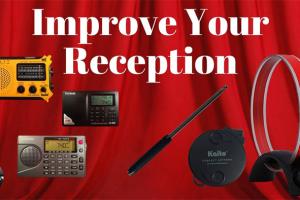Maximizing Your Sound: Effective Ways to Improve Radio Reception

-
Quick Links:
- Introduction
- Understanding Radio Reception
- Common Issues Affecting Radio Reception
- How to Improve Radio Reception
- Case Studies & Real-World Examples
- Expert Insights
- FAQs
Introduction
For many, radio is more than just a medium for music and news; it's a companion during long drives, a source of information during emergencies, and a connection to the community. However, poor radio reception can be a frustrating experience. In this comprehensive guide, we will explore how to improve radio reception for a better listening experience. We will cover the science behind radio signals, common issues that affect reception, and practical steps you can take to enhance the quality of your radio experience.
Understanding Radio Reception
Radio waves are part of the electromagnetic spectrum and travel through the air in waves. Understanding how these waves propagate and are received can help us troubleshoot and improve our radio experience.
The Basics of Radio Waves
Radio waves are generated by radio transmitters and travel at the speed of light. They can be affected by various factors, including:
- Distance from the transmitter
- Obstacles such as buildings and mountains
- Atmospheric conditions
- Interference from other electronic devices
Common Issues Affecting Radio Reception
Before diving into solutions, it’s crucial to identify the common issues that can hinder radio reception.
1. Distance from Transmitter
The further you are from the radio station's transmitter, the weaker the signal will be. This is especially true for FM radio, which has a more limited range compared to AM.
2. Physical Obstacles
Large buildings, hills, and trees can obstruct radio waves. Urban areas may experience more signal interference due to the density of structures.
3. Interference from Other Devices
Electronic devices such as microwaves, computers, and even fluorescent lights can cause interference affecting radio signal quality.
How to Improve Radio Reception
Improving radio reception is often a matter of making simple adjustments and upgrades. Here are some effective methods:
Antenna Positioning
The position and orientation of your antenna can significantly impact reception quality. Here are some tips:
- Height Matters: Higher antennas tend to receive better signals.
- Orientation: Experiment with the angle and position of the antenna to find the best reception.
- Clear the Area: Ensure there are no obstructions between the antenna and the transmitter.
Upgrading Your Antenna
If you’re using a standard antenna, consider upgrading to a more efficient model. Options include:
- Directional Antennas: These antennas focus on a specific direction and can improve reception from a particular station.
- Outdoor Antennas: Installing an outdoor antenna can significantly enhance signal strength, especially in rural areas.
Using Signal Amplifiers
Signal amplifiers can boost weak signals, making them clearer. Consider the following:
- Types of Amplifiers: There are inline amplifiers and those built into antennas. Choose one based on your setup.
- Proper Installation: Follow manufacturer instructions for optimal performance.
Reducing Interference
To minimize interference, consider the following strategies:
- Use Shielded Cables: High-quality cables can reduce signal interference.
- Relocate Devices: Keep radios away from other electronic devices that may cause interference.
Case Studies & Real-World Examples
Improving radio reception can often be a trial-and-error process. Below are some real-world case studies showcasing effective strategies:
Case Study 1: Urban Reception Improvement
A resident in a densely populated city struggled to receive FM signals. By elevating their outdoor antenna and adjusting its direction, they improved reception quality significantly.
Case Study 2: Rural Signal Boost
A family living in a rural area upgraded their standard antenna to a high-gain directional antenna, resulting in a noticeable improvement in both clarity and range.
Expert Insights
We consulted with radio technology experts to gather insights on improving reception. According to Dr. Jane Smith, a radio frequency engineer, "Investing in a good quality antenna and understanding the environment can make all the difference in radio reception." Additionally, she emphasizes the importance of continuous experimentation with antenna placement.
FAQs
Here are some common questions related to improving radio reception:
- Q1: Why is my radio reception so poor?
- A1: Poor reception can be due to distance from the transmitter, physical obstructions, or interference from other devices.
- Q2: Will an antenna booster help?
- A2: Yes, an antenna booster can amplify weak signals and improve sound quality.
- Q3: How can I tell if my antenna is faulty?
- A3: If you experience frequent signal drops or poor clarity, your antenna may need replacement or adjustment.
- Q4: Do indoor antennas work well?
- A4: Indoor antennas can be effective but typically offer less range than outdoor antennas.
- Q5: Can weather affect radio reception?
- A5: Yes, atmospheric conditions like storms can temporarily interfere with radio signals.
- Q6: How do I position my antenna for the best reception?
- A6: Try different heights and angles, and avoid obstructions to find the optimal position.
- Q7: Are there specific antennas for AM and FM?
- A7: Yes, AM and FM signals operate differently, so using an antenna designed for the specific band is advisable.
- Q8: What is the best type of antenna for rural areas?
- A8: High-gain directional antennas are often the best choice for rural locations.
- Q9: Can I use a TV antenna for radio?
- A9: Some TV antennas can pick up FM signals, but specialized radio antennas are recommended for optimal performance.
- Q10: Is it worth investing in an outdoor antenna?
- A10: Yes, outdoor antennas generally provide better reception than indoor models, especially in low-signal areas.
Random Reads
- How to set browser homepage yahoo
- Mastering little alchemy
- Mastering linux running files
- How to track a cell phone
- How to trace the location of a phone number
- Mirror hard drive windows
- Mastering your turntable guide
- How to listen police radio online
- Mastering matlab functions
- Mastering mobile app development